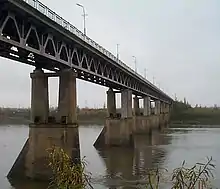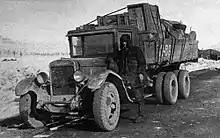R504 Kolyma Highway
The R504 Kolyma Highway (Russian: Федеральная автомобильная дорога «Колыма», Federal'naya Avtomobil'naya Doroga «Kolyma», "Federal Automobile Highway 'Kolyma'"), part of the M56 route, is a road through the Russian Far East. It connects Magadan with the town of Nizhny Bestyakh, located on the eastern bank of the Lena River, opposite of Yakutsk. At Nizhny Bestyakh the Kolyma Highway connects to the Lena Highway.
 | ||||
|---|---|---|---|---|
| Федеральная автомобильная дорога Р504 | ||||
| Kolyma Highway | ||||
The Kolyma Highway and others in the region. The Kolyma Highway is shown in red. | ||||
 | ||||
| Route information | ||||
| Length | 2,031 km (1,262 mi) | |||
| Major junctions | ||||
| West end | ||||
| East end | Magadan | |||
| Location | ||||
| Country | Russia | |||
| Highway system | ||||
| ||||

The Kolyma Highway is colloquially known as the Road of Bones (Russian: Дорога Костей, transliteration: Doróga Kostyéy).[1][2] Locally, the road is known as the Kolyma Route (Russian: Колымская трасса, transliteration: Kolýmskaya trássa).
History


.jpg.webp)

The Dalstroy construction directorate built the Kolyma Highway during the Soviet Union's Stalinist era. Inmates of the Sevvostlag labour camp started the first stretch in 1932, and construction continued with the use of gulag labour until 1953.
The road is treated as a memorial by some, as the bones of the estimated 250,000–1,000,000 imprisoned laborers[3] who died while constructing it were allegedly laid beneath or around the road, although documented sources have yet to confirm this through further evidence.[4] As the road is built on permafrost, the popular rumor spread through western and dissident accounts is that interment into the fabric of the road was deemed more practical than digging new holes to bury the bodies of the dead.[5]
Present
In 2008, the road was granted Federal Road status, and is now a frequently maintained all-weather gravel road.
When the road was upgraded, the route was changed to bypass the section from Kyubeme to Kadykchan via Tomtor, and instead pass from Kyubeme to Kadykchan via a more northern route through the town of Ust-Nera. The old 420 km section via Tomtor was largely unmaintained; the 200 km section between Tomtor and Kadykchan was completely abandoned.[6] This section is known as the Old Summer Road, and has fallen into disrepair, with washed-out bridges and sections of road reclaimed by streams in summer. During winter, frozen rivers may assist river crossings. Old Summer Road remains one of the great challenges for adventuring motorcyclists and 4WDers.
The area is extremely cold during the winter. The town of Oymyakon, approximately 100 km from the highway, is believed to be the coldest inhabited place on earth.[7] The average low temperature in Oymyakon in January is −50°C.[8] In 2020, a teenage motorist froze to death by following Google Maps directions to use the shorter but abandoned section of the road via Tomtor, on which his car broke down, and his surviving travel mate lost most of his limbs due to frostbite.[9]
Route
| Distance | Place | Remark | ||||||||
|---|---|---|---|---|---|---|---|---|---|---|
| 0 km | Nizhny Bestyakh / Yakutsk | on the Lena River | ||||||||
| 57 km (40 mi) | Tyungyulyu | end of paving | ||||||||
| 350 km (220 mi) | Krest-Khaldzhay | road, northeast, summer ferry across the Aldan River | ||||||||
| 380 km (240 mi) | Khandyga | on the Aldan River | ||||||||
| alternative: Summer Hydrofoil from Yakutsk down the Lena and up the Aldan, 530 km (330 mi), 10 hours | ||||||||||
| over Suntar-Khayata mountains, 1,200 m (3,940 ft) pass, Vostochnaya River | ||||||||||
| 700 km (430 mi) | Kyubeme | |||||||||
| 940 km (580 mi) | (New route) Ust-Nera | on the Indigirka River, east: several mining towns, Artyk town, headwaters of the Nera River, 1,452 m (4,760 ft) pass | ||||||||
|
alternative: (Old Summer Road route) 155 km (100 mi) northeast to Tomtor, 250 km (160 mi) road northeast (may not be passable except when frozen), into Magadan Oblast | ||||||||||
| 1,240 km (770 mi) | Kadykchan | (nearby are coal mines and the old Myaundzha uranium processing centre) | ||||||||
| 1,330 km (830 mi) | Susuman | |||||||||
| 1,500 km (930 mi) | Debin | with the Kolyma River bridge | ||||||||
| 1,680 km (1,040 mi) | Orotukan | road turns southeast and south 300 km (190 mi) of largely unpopulated taiga | ||||||||
| 1,759 km (1,090 mi) | Gerba | road 44H-3 to Omsukchan forks off; beginning of Anadyr Highway | ||||||||
| 1,830 km (1,140 mi) | Atka | enters lowlands | ||||||||
| 1,926 km (1,200 mi) | Yablonevyy | pavement recommences [10] | ||||||||
| 1,950 km (1,210 mi) | Palatka | |||||||||
| 1,980 km (1,230 mi) | Sokol | |||||||||
| 2,030 km (1,260 mi) | Magadan | |||||||||
There is also a scenic shortcut from Magadan to Susuman via Ust-Omchug called the Tenkinskaya Trassa, which receives a lot less heavy traffic than the main section of the M56 between Magadan and Susuman.
Distances: Yakutsk to Khandyga 380 km (240 mi), on to Kyubeme 320 km (200 mi), to Kadykchan (via Tomtor) 420 km (260 mi), Kadykchan to Susuman 90 km (60 mi), Susuman to Magadan 630 km (390 mi). From Kyubeme to Kadykchan north via Ust-Nera (the new, maintained section) is about 650 km (400 mi).
As of summer 2010, the Old Summer Road via Tomtor was still passable to motorcycles and 4×4s.
Road to Chukotka
The Anadyr Highway from the Kolyma Highway to Anadyr in Chukotka passes Omsukchan, Omolon, and Ilirney with branch roads to Bilibino and Egvekinot, involving construction of 1,800 kilometres (1,100 mi) of road.[11] The construction of the first 50 kilometers of the road started in 2012.
See also
Notes
- Warren, Marcus (10 August 2002). "'Road of Bones' where slaves perished". The Daily Telegraph. London. ISSN 0307-1235. OCLC 49632006. Archived from the original on 17 September 2012. Retrieved 5 February 2012.
- Westcott, Gary & Monica (2012). "Road of Bones to the Coldest Place in the World –". Russian Life. Archived from the original on 21 November 2018. Retrieved 5 February 2012.
- Hochschild, Adam (2003) [1994]. "17: Beyond the Pole Star". The Unquiet Ghost: Russians Remember Stalin. Boston: Houghton Mifflin Harcourt. p. 237. ISBN 9780547524979. Retrieved 14 June 2017. "Secret police authorities in Kolyma today say there are records - sometimes a complete file, sometime just a name on a list - of two million men and women who were shipped to the territory between 1930 and the mid-1950s. But no one knows, even approximately, how many of these prisoners died. Even historians who have spent years studying Kolyma come up with radically different numbers. I asked four such researchers, who between them have written or edited more than half a dozen books on the gulag, what was the total Kolyma death toll. One estimated it at 250,000, another at 300,000, one at 800,000, and one at 'more than 1,000,000.'"
- Thompson G., (2002) Kolyma – The Road of Death
- Middleton, Nick, Going to Extremes
- Colebatch, Walter. Siberian Extreme 2010 – Back for More, 8 July 2010. Retrieved 25 July 2014.
- p. 57, Extreme Weather: A Guide & Record Book, Christopher C. Burt and Mark Stroud, New York: W. W. Norton & Company, 2007, ISBN 0-393-33015-X.
- Погода и Климат. Retrieved 25 July 2014.
- Stewart, Will (11 December 2020). "Man frozen to death after Google Maps wrong turn". news.com.au. Archived from the original on 8 July 2021. Retrieved 30 December 2020.
- "Google Street View". Google. Retrieved 22 April 2022.
- Project to build road from Kolyma to Anadyr drawn up
References
- Bloom, L. R. and Vince, A. E. (2006) Mondo enduro: the ultimate adventure on two wheels – 44,000 miles in 400 days, Findon: RippingYarns.com, ISBN 1-904466-28-1
- Higgins, A (22 November 2020), "Along Russia's 'Road of Bones,' Relics of Suffering and Despair", New York Times, retrieved 3 October 2023
- McGregor, E., Boorman, C. and Uhlig R. (2005) Long way round : chasing shadows across the world, London : Time Warner, ISBN 0-7515-3680-6
- Pedersen, H., Payne, D. and Squire, S. (1998) 10 Years on 2 Wheels: 77 Countries, 250,000 Miles, Elfin Cove Press, ISBN 0-944958-38-9
- Scott, A. (2008) The Road Gets Better From Here, Vivid Publishing, ISBN 0-9804934-0-4
- The Long Course route and GPS track
- Thompson, G. (2002) Kolyma – The Road of Death, The Mission Reporter, Florida : Dundee, www site [accessed 21 May 2007]
- Turtle Expedition
- AskYakutia.com : Road condition reports
External links
- Description of a road expedition Yakutsk-Magadan and back
- Zoltan Szalkai made a documentary of Gulag camp of Kolyma.
- Documentary *** GOLD*** - lost in Siberia was filmed in the summer of 1993 in Magadan, and along the Road of Bones, through Ust-Omchug and Susuman to the Sverovostok Zoloto gold mine, Siberia, by the first foreign film crew ever, visiting the Kolyma District -which had been under control of the Soviet secret service, under the company name Dalstroj, for over 60 years.